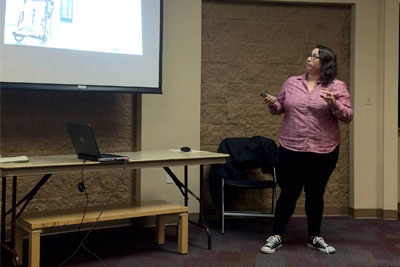Amanda Mohaimany-Aponte, a Ph.D. student working with Dr. Candace Floyd’s lab in the Department of Physical Medicine & Rehabilitation at UAB, explained how her research is making efforts to manage pain in spinal cord injury (SCI) patients at the Discoveries in the Making event at Homewood Library on February 18, 2016.
 There are more than 300,000 patients suffering from SCI in the U.S. Approximately 12,500 new cases of spinal injuries develop annually, mainly as a result of car accidents. SCI patients suffer from numerous complications, primarily including (1) loss of bowel and bladder control, (2) chronic pain, and (3) motor function issues. Amanda’s research is focused on how to manage the chronic pain in SCI patients, as it is a serious outcome that 60 to 80 percent of SCI patients experience.
There are more than 300,000 patients suffering from SCI in the U.S. Approximately 12,500 new cases of spinal injuries develop annually, mainly as a result of car accidents. SCI patients suffer from numerous complications, primarily including (1) loss of bowel and bladder control, (2) chronic pain, and (3) motor function issues. Amanda’s research is focused on how to manage the chronic pain in SCI patients, as it is a serious outcome that 60 to 80 percent of SCI patients experience.
Following an injury to any site on the spinal cord, secondary injury spreads damage out from the site of injury and has been shown to last months to years after SCI. This process involves edema, inflammation, oxidation, immune cell activation and infiltration. SCI persists chronically and results in disruption in morphology and function of the spinal cord. The exact mechanism involved in neuropathic pain development in SCI patients is not clear yet. SCI neuropathic pain is characterized by hypersensitivity to painful stimuli, such as heat, or pain to non-painful stimuli, such as touch.
Unfortunately, there are few effective treatments for SCI neuropathic pain. Since more than 80 percent of SCI affect men and more than 50 percent of Americans suffering from SCI are between 16 and 30 years of age, Amanda’s research targets treatment of SCI neuropathic pain in young adult males. Amanda focuses on developing a therapeutic agent that can be quickly and easily administered, reaches the central nervous system (brain and spinal cord) with minimum toxicity, and targets secondary injury.
The drug Amanda is currently evaluating as a potential therapeutic agent for SCI neuropathic pain is Cannabidiol. Cannabidiol is a non-psychotropic agent derived from Cannabis sativa, which has very few adverse effects. It is already used clinically for the treatment of a variety of disorders including pain disorders. Previous research show that cannabidiol can target secondary injury, but it has not been examined as a treatment for SCI neuropathic pain. So Amanda decided to test whether the administration of this drug soon after SCI will decrease the incidence of neuropathic pain.
Amanda found that Cannabidiol administered in animal models 30 minutes after SCI and then once daily for seven consecutive days decreased cold allodynia (pain sensation to non painful stimuli), suggesting that Cannabidiol lessens pain development post-SCI. On the other hand, Cannabidiol did affect motor function.
Amanda’s research shows that although Cannabidiol has promise as a therapy for SCI pain, it requires further evaluation. Her future research will continue evaluating the drug and investigating its effect on the secondary injury after SCI.